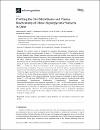Profiling the Oral Microbiome and Plasma Biochemistry of Obese Hyperglycemic Subjects in Qatar
| Author | Sohail, Muhammad U |
| Author | Elrayess, Mohamed A |
| Author | Al Thani, A A |
| Author | Al-Asmakh, M |
| Author | Yassine, Hadi M |
| Available date | 2019-12-15T06:49:33Z |
| Publication Date | 2019-12-01 |
| Publication Name | Microorganisms |
| Identifier | http://dx.doi.org/10.3390/microorganisms7120645 |
| Citation | Sohail, M.U.; Elrayess, M.A.; Al Thani, A.A.; Al-Asmakh, M.; Yassine, H.M. Profiling the Oral Microbiome and Plasma Biochemistry of Obese Hyperglycemic Subjects in Qatar. Microorganisms 2019, 7, 645. |
| ISSN | 2076-2607 |
| Abstract | The present study is designed to compare demographic characteristics, plasma biochemistry, and the oral microbiome in obese (N = 37) and lean control (N = 36) subjects enrolled at Qatar Biobank, Qatar. Plasma hormones, enzymes, and lipid profiles were analyzed at Hamad Medical Cooperation Diagnostic Laboratory. Saliva microbiome characterization was carried out by 16S rRNA amplicon sequencing using Illumina MiSeq platform. Obese subjects had higher testosterone and sex hormone-binding globulin (SHBG) concentrations compared to the control group. A negative association between BMI and testosterone (p < 0.001, r = −0.64) and SHBG (p < 0.001, r = −0.34) was observed. Irrespective of the study groups, the oral microbiome was predominantly occupied by Streptococcus, Prevotella, and Veillonella species. A generalized linear model revealed that the Firmicutes/Bacteroidetes ratio (2.25 ± 1.83 vs. 1.76 ± 0.58; corrected p-value = 0.04) was higher, and phylum Fusobacteria concentration (4.5 ± 3.0 vs. 6.2 ± 4.3; corrected p-value = 0.05) was low in the obese group compared with the control group. However, no differences in microbiome diversity were observed between the two groups as evaluated by alpha (Kruskal–Wallis p ≥ 0.78) and beta (PERMANOVA p = 0.37) diversity indexes. Certain bacterial phyla (Acidobacteria, Bacteroidetes, Fusobacteria, Proteobacteria, Spirochaetes, and Firmicutes/Bacteroidetes) were positively associated (p = 0.05, r ≤ +0.5) with estradiol, fast food consumption, creatinine, breastfed during infancy, triglycerides, and thyroid-stimulating hormone concentrations. In conclusion, no differences in oral microbiome diversity were observed between the studied groups. However, the Firmicutes/Bacteroidetes ratio, a recognized obesogenic microbiome trait, was higher in the obese subjects. Further studies are warranted to confirm these findings in a larger cohort. |
| Sponsor | Qatar National Research Fund |
| Language | en |
| Publisher | MDPI |
| Subject | diabetes exercise microbiome microbe inflammation immune response obesity oxidative stress |
| Type | Article |
| Issue Number | 12 |
| Volume Number | 7 |
| ESSN | 2076-2607 |
Files in this item
This item appears in the following Collection(s)
-
Biomedical Research Center Research [662 items ]
-
Biomedical Sciences [640 items ]


